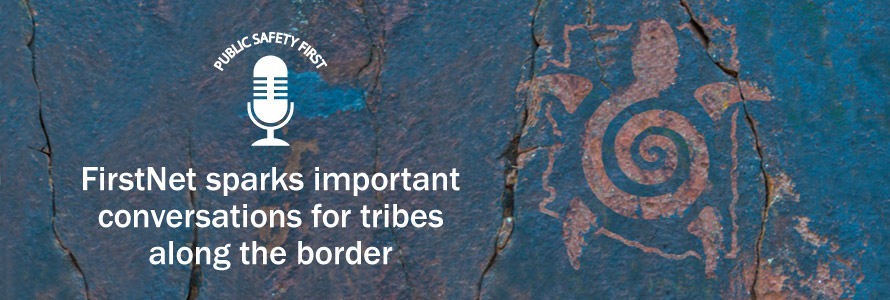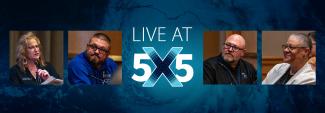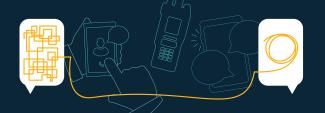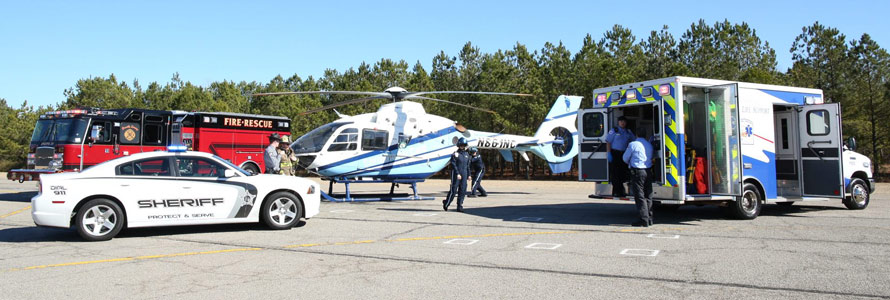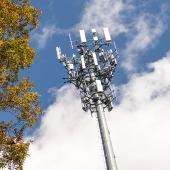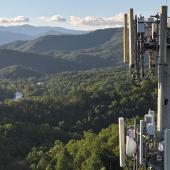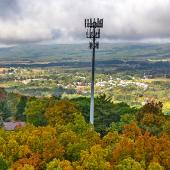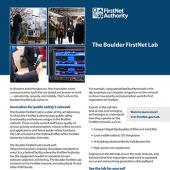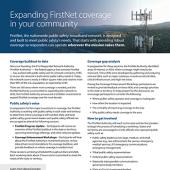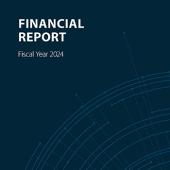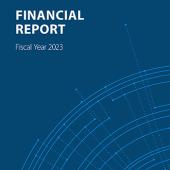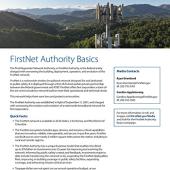Summary
In the latest podcast, FirstNet Authority National Tribal Government Liaison Adam Geisler sits down with the Inter Tribal Council of Arizona’s Executive Director Maria Dadgar to discuss the jurisdictional and geographical challenges Arizona tribes face and how FirstNet could be the solution needed.
Guest
Adam Geisler
FirstNet Authority National Tribal Government Liaison
Maria Dadgar
Executive Director, Inter Tribal Council of Arizona
Transcript
Preview
Narrator: You're listening to Public Safety First, a podcast to help you learn about the First Responder Network Authority and how you can be part of the future of public safety technology.
And now your host.
Narrator: You're listening to Public Safety First, a podcast to help you learn about the First Responder Network Authority and how you can be part of the future of public safety technology.
And now your host.
Adam Geisler: Welcome, everybody, to another episode of Public Safety First podcast – Tribal edition. I’m Adam Geisler, and I serve as the National Tribal Government Liaison with the First Responder Network Authority, so Miyuum to all my Luiseño people out there, and thank you for tuning in today. Today, I’m joined with a good friend and colleague, Maria Dadgar, who is the Executive Director of the Inter Tribal Council of Arizona. Maria is a member of the Piscataway Tribe of Accokeek Indians located in Southern Maryland, and has a long history of advocating for tribal nations through public policy and legislation. We are pleased that she could join us today, and we want to go ahead and welcome Maria to the podcast. Welcome, Maria.
Maria Dadgar: Thank you, Adam. I’m glad to be here.
Adam Geisler: Wonderful. So, Maria, we want to give everybody a sense of kind of how you got involved in working in Indian Country, and I was hoping you could start by telling us a little bit about the work that you do with the Inter Tribal Council of Arizona.
Maria Dadgar: Well, Adam, my entire career has been working in Indian Country. I first started working in Indian Country during the early ‘90s when I co-founded the National Internship Program for Native American college students. Some of you may have heard of the WINS Program – Washington Internships for Native Students. That program is a very serious internship program, and I was recruiting native college students, bringing them to DC, and placing them in internships from, anywhere from a federal agency to the White House. And so, through that program, that’s how I met some individuals that led me to move to Arizona. I’ve been living and working in Arizona for 18 years now.
Adam Geisler: So that, that brought you into the Inter Tribal Council of Arizona, then?
Maria Dadgar: Yes. The Inter Tribal Council of Arizona is the United Nations for tribes in Arizona, and we hold regular meetings – we meet with the governor, we meet with the federal representatives from different agencies, we meet with congressional delegates. We stay very busy here.
Adam Geisler: That’s wonderful. So, the Inter Tribal Council of Arizona is made up of a total of how many tribes?
Maria Dadgar: We are comprised of 21 tribes, and so that’s 21 of 22 tribal nations here in Arizona, Navajo being not an official member of the Inter Tribal Council, but we work very, very closely with Navajo.
Adam Geisler: The Inter Tribal Council of Arizona kind of has two focuses that it moves down. Would you mind sharing us, a little bit with us about what the two different arms are of Inter Tribal Council?
Maria Dadgar: Yes, about four years ago, we were advised by our attorneys to establish a 501(c)(4), and so we did, and that is called the Inter Tribal Association of Arizona, or ITAA, and so throughout the day, I’m switching hats between ITCA – the Inter Tribal Council of Arizona – which is our 501(c)(3). We have about 62 staff, almost a 20 million dollar annual operating budget, and we provide programs and services through ITCA, centering around three major areas of health, research, and environmental quality, and then everything in between.
Adam Geisler: Right.
Maria Dadgar: And also through ITCA, if I can add, we serve as a fiscal agent for four very large organizations here in the state, one of them being the ICIN, you may have heard of ICIN – Indian Country Intelligence Network. ICIN is an association of tribal law enforcement, all 22 tribal law enforcement agencies throughout the state are members of ICIN, and we house and coordinate that program on behalf of our member tribes, and, and all tribes.
Adam Geisler: Well, I’m glad you brought that up. We’ve actually really appreciated having Inter Tribal Council of Arizona and the ICIN delegate, in the past, on our Tribal Working Group, and the information and input that the, that your delegate, former delegate Nathan Nixon, had shared with us was really instrumental in us creating both the Tribal Consultation Policy as well as kind of influencing and informing our agency around tribal public safety, specifically law enforcement needs.
For our listeners that are new to Indian Country, that maybe didn’t realize that tribes regularly interact with federal agencies at that level, maybe give a little bit of information or background about that.
Maria Dadgar: Yes, in a nutshell, tribes are sovereign nations. Here in Arizona, tribes are in control of 28 percent of the land-base for the entire state, which is a very, very large land area, and we have all types of geographies. We have canyons and mountains, large desert areas that not a lot of population, so they have to manage and take care of their public safety on their own. They are in a trust relationship with the federal government and through the BIA [Bureau of Indian Affairs], tribes receive certain amount of funding to establish their police departments, but it’s, as you know, never enough funding, and so you have, you know, just a few officers kind of canvassing very, very large, desolate areas. Communication is very difficult, and so we’re excited about FirstNet and everything that you all are bringing to us.
Adam Geisler: Well, we’re excited to be here and be working with your organization as we implement our five-year build plan and obviously as we see tribes starting to come online. You mentioned geography as an element within this state. Obviously the Grand Canyon is here. So you have these crazy mountains all the way down to the deserts, and then unique jurisdictional challenges as well, but, could you describe a little bit about the geographic challenges that you have here in Arizona?
Maria Dadgar: Yes, for sure. It’s a huge challenge, and so there are sacred sites within the lands that they manage, sites that cannot be disrupted and have a lot of federal protections in place. There are a lot of habitats and natural wildlife that cannot be disturbed as well, and so tribes have jurisdiction to maintain and monitor in collaboration with several, several of our federal agencies.
Adam Geisler: In this state, what we’ve come to see is that a lot of the tribes are in really rural, remote locations, with the exception of a couple. There are a couple here in Phoenix and then the Tucson-greater area, but it seems like a majority of them are very rural. How does this impact their ability to get response?
Maria Dadgar: We, here at the Inter Tribal Council, we’re located in the sixth largest city in the United States in downtown Phoenix, but we serve 21, and really 22, tribes throughout the state. And it could take a tribal leader, you know, four or five hours to drive just to get here.
Adam Geisler: Your job takes you all over the state of Arizona, so I think you have a pretty good picture of what, how does coverage look like today in the state?
Maria Dadgar: Well I know exactly where my cell phones work, and just about – and I have two, so that’s cell phones –
Adam Geisler: Ok so you have cell phones, so to be clear you have cell phones.
Maria Dadgar: Yes, and they’re both by the same provider, and I know exactly where they work and where they don’t, and it is a matter of life and death because the state is so expansive, and then we have elevation as well as the canyon areas. Our first webinar last year, and people were telling me, “Maria, don’t try to do a webinar because so many tribes are not going to be able to access it, they’re not going to be able to participate.” And I said –
Adam Geisler: Wait, let’s – if you could reiterate that again –
Maria Dadgar: Yeah, yeah –
Adam Geisler: So it’s common for people in Indian Country to not have a form of connectivity, whether cellular or through a fiber connection?
Maria Dadgar: It’s very sad to say, but that is the truth, Adam. And it’s something that we advocate for constantly. People do not understand, you know, when you’re sitting somewhere and you can pick up your phone and call anybody 24/7, you cannot picture that someone could be without even the basic internet or cell phone service, or have service that it drops constantly while you’re trying to communicate with them. So we definitely have that here in Arizona.
Adam Geisler: So the idea of FirstNet coming on board as we expand the network across the state working with our partner AT&T, have you happened to hear any feedback from the tribal leaders about FirstNet coming online?
Maria Dadgar: Oh yeah, you coming out here established the framework for them to understand what this was all about and what it would mean for them. When we have our board meetings and we have presenters, tribal leaders are looking for the bottom line of what you’re saying so that they can make very high-level decisions on behalf of their communities, and when you’re bringing something like FirstNet, this public safety spectrum that will help maintain security for their tribal members, then you have their full attention. And so they were really glad to learn about it and understand the timeframe and probably, while you’re here, it’s probably a good time to get you to come back out and just share where you are right now because it’s very, very important to them and they all understand being in a rural area and not being able to contact help. Just the feeling alone is a very isolating feeling.
Adam Geisler: Maria, it’s hard to talk about Arizona without bringing up jurisdictional elements, such as working with federal partners, working along the border. I know a number of tribes in this state work on a daily basis with a variety of federal law enforcement partners, but other partners as well, which creates a really unique environment for coordination and mutual aid. Do you want to share a little bit about what it’s like, maybe from the mind of a tribal leader for those that may not understand all the elements that are being juggled at one time when you’re dealing with tribal land in this state?
Maria Dadgar: Yes, absolutely. You know, for our tribes that are along the border, they have heightened safety issues that they face and that they deal with because they don’t see the border as this wall or this place that they don’t pass. That is their traditional homelands, and the people on both sides are their relatives. And so they travel back and forth, they have ceremonies that they participate in, and it’s part of their culture, and that is not going to change. But they do have safety incidents that happen. I know people in those areas, the Border Patrol officer could get hurt just as easily as a tribal citizen going back and forth, and so the rural nature of these areas makes it especially dangerous, where if someone was to get hurt, you know, they would have a difficult time reaching out for help, and so public safety is a huge issue, just because these are tribal lands and they have a huge border along the Mexican border that they share with Mexico. Those areas are open for a lot of people to travel through. A lot of times when people think of tribes, they just want to separate them out – “Oh, that’s just a tribal thing.” No, that’s a public thing, you know, and so, but tribes are very cooperative and willing to help. And it’s also through ICIN – Indian Country Intelligence Network – that we communicate with Border Patrol, and we invite them in to keep our tribal law enforcement updated so that they have strong relationships and can communicate well.
Adam Geisler: So do you see FirstNet helping improve the way that they are communicating into the future, the tribes and Border Patrol in your example?
Maria Dadgar: Yes. I really see FirstNet as a lightning rod for these important and difficult conversations to take place. There’s a lot of emotion that’s surrounding this issue of borders, and for people who are used to traveling and going without, you know, worrying about the issue of, you know, there’s a wall or something like that, they’re not going to stop. This is a way of life. And so having that open communication and FirstNet being there to instill this framework for how we’re going to communicate in times of need, I think is just going to be really a very innovative way for tribes to participate and move forward.
Adam Geisler: That’s, that’s interesting, that’s the first time I think we’ve heard anybody describe FirstNet as being a way to maybe help create a platform for conversation around technology as a potential solution for some of the issues that they are dealing with in the border region, so I appreciate you sharing that perspective.
Shortly ago, you had mentioned to me before hopping on the podcast the coordination that had gone on and the involvement that the tribal leadership had in the state as a whole in supporting, via resolution, the adoption of the state plans by the governor. Do you want to share a little bit about that?
Maria Dadgar: Yeah, so the tribal leaders, they are my direct bosses, and I report directly to them, and they are our board of directors for our nonprofit. And so we hold regular board meetings. And it was through one of our board meetings that we invited and you gave a presentation, and then the tribal leaders, one, proposed that we support you and this effort with a resolution, and so the resolutions are voted on and passed by tribal leaders and signed off and it carries a lot of weight in the state as well as on a national level. I’ve hand-carried them to certain people, and when I place it in their hands, they just start shaking because of the weight, you know, they understand the weight and the power behind having the collective voice of all tribal leaders in Arizona on that document. And so, the tribal leaders really wanted to see the state opt-in, and so that was one of the tools that they used, as well as a letter, which we hand-carried to Governor Ducey, and so we were very, very proud and glad to see when he did opt-in.
Adam Geisler: Well that’s exciting. I think that it’s good to hear the excitement around FirstNet as it’s coming online. The tribes have been taking a proactive approach, the governor has taken a proactive approach. It sounds like there’s a really great need in terms of public safety having a, this new tool that’s coming online. But I don’t want to also paint this as all rosy, either. We still have a lot to learn in our organization, and we always want to make sure that, you know, as we’re having these dialogues with influencers and practitioners and individuals such as yourself that we’re hearing what we need to be hearing, so we’re kind of reaching a point in the segment where I’m hoping you can kind of share with us a little bit about what maybe we need to know in working in Indian Country, or anybody for that matter, when it comes down to FirstNet, what are things that we should be aware of, or what can we do to improve our relationships in working with tribes?
Maria Dadgar: I think in general, and I’ve worked in tribal economic development for many years, and I’ve known there were times when companies would pass through fiber optics through tribal land and then the tribe not be able to tap into it to utilize it in any way, and I think there might be a fear that this is going to, you know, come and kind of be, you know, set up and they may, tribes may not have the control or the true access that they wish, and I think that, just make sure that you get that message out there that they have a lot of say in how this is going to roll out for their communities and how they’ll be able to participate and, I’ve had a few tribes ask if there could be some other alternative use to FirstNet if there is not an emergency taking place, so whether that’s true or not, I don’t know, but I think that’s part of your messaging, and maybe that’s a future thing that could happen, I don’t know, but just those kinds of things, think about the economics side of what it might mean, you know, whether it’s positive or negative, but I think that tribal leaders are thinking in those terms of economics for their communities. But, overall I think, as long as you, and you’re always there right where you should be, sharing the information and messaging, just keep doing that, and then I think it’s time for us to have you back out to another board meeting so that you can just give an update. That regular communication, which you all are very good at, outreach and letting tribal leaders know and answering those tough technical questions, and those kinds of things mean a lot to tribal leaders because when you’re standing there, talking to them, what they’re really trying to glean is the bottom line, you know, and what does this mean to my community, and the information that you share will enable them to make the best and the highest decision on behalf of their people.
Adam Geisler: This is probably my favorite part of the podcast, which is, is there anything else that you want to share with the listeners that we didn’t share today that you think is important for them to know about Indian Country, about Inter Tribal Council, about FirstNet, this is your time to share.
Maria Dadgar: Well I always say, and I think I said it earlier, Inter Tribal Council is the United Nations for tribes in Arizona, and so the tribal leaders agree that this will be the place where they have very difficult conversations and share things amongst themselves and to work on solutions, and so, that could mean amongst themselves or community members or beyond – federal, state agency may have some interaction that they want to have with tribal leaders. This is the place to have that forum and, I think, what I would like people to always understand is that tribal leaders are elected officials, and they have to make very, very difficult decisions, and they don’t always have a lot of time, and so they’re looking for, you know, high level information to enable them to make the tough decisions on behalf of their people, but they’re always looking to do the best that they possibly can, and they’re very, very humble in the work that they do and the amount of responsibility that they carry. It’s just, it’s an honor for me to work with them and to help provide the context and the connections with people like you and projects like FirstNet, which I think is going to help everyone.
Adam Geisler: Well, with that, Maria, I just want to go ahead and say thank you so much for hosting us here at the Inter Tribal Council of Arizona’s offices here in Phoenix, and for taking a few moments out of your day to share a little bit about how the organization functions and what you work on, and for your dedication to public safety, I want to say thank you.
And to everybody else out there that is listening and spending the time today to hear a little bit about the Inter Tribal Council of Arizona and FirstNet on our podcast, we want to say thank you and No$úun Lóoviq. Have a great day.
Maria Dadgar: Thank you.
Narrator: Thanks for listening today. We're excited to have you join our podcast community. Make sure to subscribe on iTunes, SoundCloud, and YouTube. You can learn more about the First Responder Network Authority at FirstNet.gov and learn about FirstNet products and services at FirstNet.com.


